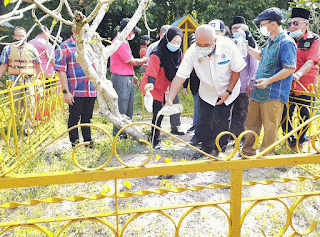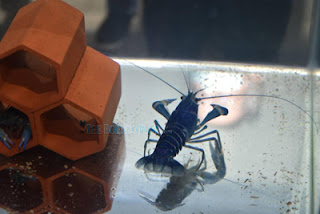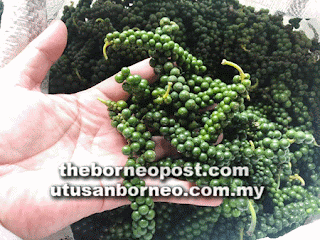THE key amendments of ArticlesI(2), 1(4),2(a), 46with new Articles 2A and46A after amendments of Sections 4, 8& 9 of MAct63 to restore the 4 altered boundaries under Article 2(b)
The Federation under Article 160(2) must be amended to mean “the Federation established under the Federation of Malaysia Agreement 1963” to be constitutionally, historically and legally correct.
The unconstitutional, ‘Federal Territories’, a hybrid parliamentary creation to gain seats in the House of Representatives, must be approved underthe amended Articles 2(a), after amending Sections 4, 9 of MAct63 and Article 46 with the new Articles 2A and 46Apassedto ratify the lacunas of the constitution and that limbo status.
The critical Article 2 must be amended as follows :
2. Admission of new [States or Federal Territories] into the Federation Parliament may be law –
(a) Admit other States [or Federal Territories]to the Federation;
(b) Alter the boundaries of any States.
(c) [Approve the exit of States or Federal Territories of the Federation.]
But a law altering the boundaries of a State [or a Federal Territory]shall not be passed without the consent of that State (expressed by a law made by the Legislature of that State) and of the Conference of Rulers.”
The amendments in square brackets must be made to ratify the constitutional lacunas and limbos. There is a fundamental difference between the constitutional ramifications between the proviso of Article 2(b) on the alterations of Sarawak’s 4 boundaries and the same alterations of boundaries under “promoting uniformity of the laws of two [Sarawak and Sabah] or more States.”
Under the proviso of Article 2(b), parliament cannot pass any Federal law against Sarawak and Sabah unless Legislative Councils of the Borneo States have consented by a law expressly already passed by their Legislatures first. But, under Article 76(3), 80(3) and 95D, Parliament can pass the federal laws first but cannot be enforced against Sarawak and Sabah unless they have been passed or adopted the same federal law subsequently as their municipal laws.
So, the amendments by the various parliamentary committees must center holistically on all the Articles of I, I(4), 2(a), 46, 161E(3) with new Articles 2A and 46A,after amending Sections 4, 9 and 66(3) of MAct63 first, not only on Article 1(2).All those 5 offending void and illegal Acts must also be amended constitutionally and properly under the proviso of Article 2(b) and pertinent Sections of MAct63 under a Supplementary Agreement first. Then the final parliamentary Bill under this paramount constitutional procedure would require the consents of the Borneo States’Legislatures on that final Bill to be identical to the municipal laws already passed by them.
In brief, the five offending Acts shall be now amended under the mandatory provision and proviso of Article 2(b), otherwise, that final parliamentary Bills “shall not be passed without the consent of the State “[Council Negeri]”, namely, by passing that same law expressly in the first place bySarawak or Sabah. That is an absolute taboo.
Therefore, strictly for the breaches on the alterations of the four boundaries of Borneo States, parliament could not have passed the five offending Acts under Article 2(b) to be enforced against them. Since in practical terms, these Acts were already passed, an express entrenched constitutional proviso must be inserted, namely that:
“This Act shall not be applicable to the coastal States of Sabah and Sarawak.”
These five offending Acts,though in breach of Article 2(b),now can still constitutionally be rectified and ratified by parliament by amending those offending Acts with that exemption clauses above and by incorporating new Articles 2A(1), (2), (3) and (4) from the specific provisions of UNCLOS 1982 and new Article 46A similarly to be passed clearly as the federal laws to be the same by adopting the same municipal laws to bepassed or already passed by the Legislatures of the Borneo States.
2. Steps for Sarawak’s and Sabah’s Legislatures to implement under the proviso of Article 2(b).
Under the proviso of Articles 2(b), the Borneo States’ Legislatureshave :
Firstly, to pass the four municipal laws based on UNCLOS, as the municipal laws first to rectify and ratify the serious violations on the void and illegal alterations of the four boundaries of Sarawak and Sabah.
So, the amended Parliamentary Acts must follow the municipal laws to be promulgated by the Borneo States already based on Article 2(b), UNCLOS, 7PMs and 7FCs to protect their four boundaries that strictly our Federal Parliament could not have legislatedthe five offending Acts against them.
1) Unfortunately the present Article 1(4) on the “admission” of the 3 unconstitutional and void FTs were not “States” under Article 160(2) nor in the original Article I in 1963 nor in Section 4 MAct63 nor in FMA1948 or 1957. In Article 2(a), FTs are not ‘States’ of the federation. A Federal Territory is not equivalent to the States of Malaya nor the Borneo States. It is a federaland parliamentary hybrid creation of a small area excised from the individual State in the federation under the exclusive jurisdiction of the federal government under the pressure of political alignment imposed to get extra parliamentary seats primarily and development under the direct federal control inside that particular State.
2) The solution is for the identical Section 4 of the MAct63 which must constitutionally be amended first as it was expressly inserted as Article 1 of the FC under Section 3 and its First Schedule of the MAct63. This amendment must be done by a Supplementary Agreement including Sections 9 and others of MAct63, the ‘Mother of FC’, first before amending Articles I(2), I(4) and 46 of the FC, Article I and Article 2(a) with new Articles 2A and 46A in the spirit and letter of MA1963 which would seem to supersede the FC in the event of any conflict of interpretation under constitutional and international law.
3) The original Article 1(2)(c) in respect of the exit of Singapore was deleted or amended without amending properly by a Supplementary Agreement above mentioned. So, the deletion of Article I(2)C on Singapore under MAct63 in 1966 by Act59/66 under Article 2(a) of FC was unconstitutional and void. That have to be ratified under the proper constitutional procedures. The proposed Bill on Article 1(2) and the amendment of various Articles and Sections of MA63 should have been also in English which is a richer language, clearer with definitions of various legal concepts based on centuries of case laws for a better understanding and interpretations with at least two weeks’ notice of that Bill for the MPs to carry out their duties properly with proper legal advices.
4) So Article 2(a) on ‘admission’ has to be amended and ratified to include ‘Federal Territories’ apart from “other States to the Federation” to be constitutionally correct and agreed by the Borneo States as well, as these Federal Territories are not States and the 13 seats are in the constitutional limbosat best for them to perform their duties as MPs with the financial benefits.
Secondly to advise clearly the federal government that :
1) Sarawak and Sabah did not expressly pass their municipal laws in their respective Legislatures first nor adopt those 5 offending Federal Acts.
2) It is incomplete, meaningless and useless to amend Article I(2) alone without amending Articles 1(4), 2(a) and inserting the Article 2(c), along with Article 46, new Article 46A, with Sections 4, 8 and 9 of MAct63 to be amended first, to admit the 3FTs constitutionally and legally under Article 1(4), 45 and adopt the pertinent provisions of UNCLOS 1982 under a new Article 2A to update the federal law to bepassed by the Borneo States’ Legislatures first since the ratification with effect from 14th November 1996 by Malaysia.
3) The Borneo States have not amended first under Sections 4, 8, 9 and 66(3) of MAct63 constitutionally and Article 2 specifically under the Supplementary Agreement to MA1963 before amending Articles 45, 46, 1(2) and 1(4) on the unconstitutional and void increase of the seats for the House of Representatives on or after the 9th August 1965 on the Separation Agreement on the exit of Singapore. Therefore, that exit was also unconstitutional and void, so a retrospective amendment under the new Article 2(c) is mandatory. The four void Senate members of FTs under Article 45 would need ratification.
The Borneo States were deliberately kept in the dark; and so had lost that opportunity to get the Prime Minister Lee Kuan Yew, our PM and Deputy PM of Malaysia to reconfirm the ‘no two-third rule’ by the States of Malaya, namely before the formal exit and necessary amendments for the 15 seats of Singapore to be assigned irrevocably to Sarawak and Sabah proportionately 24 to 16 ratio to maintain that 65.4 per cent or ‘No two-third rule’ for the States of Malaya plus FTs later on, under Section 9 of MA63 and Article 46, as amplified below.
Indeed that unconstitutional and void amendments of Articles 46 and I(4) the Federal and the States of Malaya have breached the ‘no two-third rule’ or 65.4 per cent voting power of the States of Malaya. These serious constitutional violations and the ultra vires ‘admission’ of the 3FTs under Sections 4,8 (4seats for the Senate under Article 45) and 9 of MA1963 and purported ArticlesI(4) and 46 of the FC and Article 2(a) have paved also for the unconstitutional increase of seats for the States of Malaya including the 13 parliamentary seats for the FTs against the spirit and leter of the constitutional, international and legal documents of MA1963. Yes, the oral assurance also under Article VIII of MA63,as well asunder Article 2(a) of the FC and Article 3(a) of the Vienna Convention on the Law of Treaties and Customary International Law.
This was clearly confirmed by Section 9(2)(a) of MA63insertedas the original Article 46(2)(a): “One hundred and four members from the States of Malaya” “out of one hundred and fifty nine elected members,” namely, 65.4 per cent which must be amended by a Supplementary Agreement before amending the identical Articles 46 and I(4).
Thirdly,
i. On the admission of the FTs under Article I(4) with completejurisdiction and direct control of the federal government, that constitutional lacuna would need to be ratified by amending Article 2(a) after amending Sections 4 and 9 of MAct63 first to read as follows: “(a) admit other States or [Federal Territories] to the Federation.” A State of the Federationis very different from the “Federal Territories” excised out from different States.
But the ‘Territories of the Federation’ under Article I(4) is not defined nor being included under Article 160(2) nor in MA63 nor in MAct63 nor in FMA1957, but a federal parliamentary hybrid creation attempting to ‘usurp’ the status of a State and unconstitutionally to assert unilaterally its erroneous rights to the 13MPs seats so far.
Sarawak government has refused to let the federal government to declare the enlarged Bintulu Development Area as a Federal Territory during the watches of YAB Tun Rahman and YAB Tun Pehin Sri Taib Mahmud.
An offence of ‘transmitting’ wireless communication is not an offence in ‘receiving’ it,unless it states otherwise.
ii. But, for the exit of Singapore, the compulsory constitutional amendment for ratification is to insert a new Article ‘2(c)’ to read as follows :
“To approve the exit of States or Federal Territories of the Federation”
But the quid pro quo for the necessary amendments to restore MA63 will be thefundamental reasonable pre-conditions by Borneo States to demand the restoration of that“no two third rule” for the States of Malaya and the 3FTs on which they must accept as the fair trade-off for necessary ratifications of the constitutional lacunas and limbos of the Federal Territories under Articles 1(4), 2(a),1(2), 45(Senate), 46 and fundamental breaches of the proviso of Article 2(b) and corresponding Sections of M Act 63 apart from the 7FCs and 7PMs.
iii. As for the preconditions for amending Sections 4 and 9 of MAct63 first, then Article 46, 1(2), 1(4), 2(a) with new Articles 2A and 46A proposed to satisfy properlythe unconstitutional 13 seats of the FTs in the parliament and 4 seats in the Senate, 32 new seats must be legislated to be addedto the total House of Representatives from 322 to 354, with the 32 new seats to be allocated to Sarawak and Sabah in the ratio of 31(18) to 25(14) to maintain the ‘no two third rule’ of the States of Malaya and the Federal Territorieswith 65.4 per cent only since 1963,as they hadonly 104 out of 159parliamentary seats originally. Besides,the Borneo States are so much bigger than theStates of Malaya with bigger population nowthan in 1963 that that would warrant an increase of 32 seats now,good for all political parties in the rural areas conducive for greater rural development.
iv. Parliament has also need to pass four amendments as Article 46A, namely by:
a) Stipulating that from the date of the amendment, the States of Malaya and its Federal Territories shall henceforth not have more than ‘two-third’ or 65.4per cent of the total seats of the House of Representatives under the amended Article 46 and Section 9 of MA63 to ratify Article I(4), otherwise, ipso facto, the 13MPs from the 3FTs would be disqualified under Articles 47 and 48, namely, FTs are not States of the Federation under the FC, so those MPs from the FTs are disqualifiedas membersof the House of Representatives and Senate under Article 45 of the FC and void under Article 4(i).
b) Stipulating that 32 new seats in the House of Representativesshall be increased to maintain the “no two-third rule” for the States of Malaya and the Federal Territories at all times from 222 seats to 254 seats now to be allocated at the ratio of 31 to 25 for the States of Sarawak(18) and Sabah(14). The said no two-third rule shall further apply to the States of Malaya and the Federal Territories for the increase of the Parliamentary seats in future.
c) Stipulating that the amendments of Articles 1(2), 1(4) and 46 must be made only after the amendments of Sections 4 and 9 of the MAct63 and Articles 2(a) and (c) with new Articles 2A and 46A under a Supplementary Agreement to be signed by the remaining three parties of MA63, namely the States of Malaya (but not FTs which will never be a state under Article 160(2), Sabah and Sarawak before the 3FTs under ArticlesI, 1(4) and 46 can be constitutionally amended.
d) On the four unconstitutional appointments of the FTs to the Senate under Article 45, Section 8 of M Act 63 must first be amended under the same Supplementary Agreement.
“That’s unconstitutional… but I have promised our Sarawakians and the PM”,muttered languidly the late YAB Tok Nan in his nightmares. “
“Your hot pursuit of 20 per cent royalty and restoration of MA63 will shorten your life,” warned the writer.
“That’s quite alright… I’ll take up this Ulysses’s ‘fight’ and please brief our State leaders and share your research and knowledge from Lord McNair and the Jennings, since Rumah Malaysia and Cambridge days, and advice with all.”
Brave leaders in history are always few and far in-between,as one would say.
Tok Nan wanted the Federal Government to accept under the entrenched FC Sarawak’s right to issue the licences of its own O&G.
Yes, pay the 20 per cent, royalty and fulfil all the grants, assurances and restore all the eroded rights, then on the legal and political settlements, Putra Jaya would share 65per cent of Sarawak’s O&G as Sarawak’s national service, for our nationalinterest, for our people, for our King and Country.
These holistic amendments will reflect the true spirit and implementation of the restoration of MA1963 under the Rule of Law proclaimed by our Prime Minister to make Putrajaya shining again on the hill in these ultimate legal and political settlements for the three remaining parties under MA63 to move forward constitutionally, legally and politically.
That will ensure the mutual prosperity and benefits of Borneo States’ O&G under a shining amended constitution with 20 per cent royalty or local sale tax for Sarawak and Sabah and 65 per cent for the Federal Government.
The Borneo Post Copy Right Reserved.























